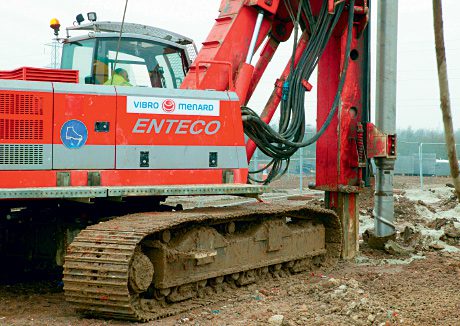
A ground improvement specialist has completed work at the site of the new Manchester Waste Private Finance Initiative building in Bolton. The £250,000 contract was won by Vibro Menard and used CMC, a new technique for the UK market.
The company, working with main contractor Costain, installed 1,793 controlled modulus columns (CMC) up to 3-12 metres deep and 320mm in diameter. The soils below the waste intake and maturation building weighbridge area and amenity building presented soft conditions composed of made ground over clay. The area that required to be improved was around 90,000 m2.
In the area where the buildings will be erected, some earthworks cut and fill was required, with a maximum fill of approximately 3.5 metres and a maximum cut of three metres. Construction of the structures without soil improvement or soil replacement would have led to unacceptable post construction settlements and deformation.
The completed slab at the Bolton site will measure 89 metres by 260 metres while the 250mm thick concrete slab will be built on a 600mm thick load transfer platform, formed in two layers of high-quality granular fill with the first 300 metres placed ahead of the ground improvement work to act as a working platform for Vibro’s rig.
Vibro Menard’s CMCs are used to improve soil characteristics in weak ground and to reduce imposed settlements caused by the proposed structure. The columns are installed using a specially-designed auger that displaces the insitu soils laterally, with virtually no vibration or spoil, and reduced risk of contamination.
The auger is screwed in to soils to the designed depth, which increases the density of the surrounding soil, and as such increases its strength and/or bearing capacity. When the auger is extracted a column is developed by pressure grouting, at less than 5 bar, to improve surrounding soils. The result is a composite ground improvement solution offering improved stiffness characteristics, allowing the CMCs and the surrounding soil to share the imposed loadings. After installation, columns are covered by a designed load transfer platform, between 0.4 and 0.8 metres thick, to transfer load from the structure to the CMC/soil matrix.
Gerry Crawford, Vibro Menard’s general manager, said: “Using ground improvement was more cost effective for the client; a piled solution would have required spoil disposal and a suspended floor slab that would have had to have been thicker and need more reinforcement. We were also extremely confident that the work could be delivered in three weeks rather than the originally proposed seven, representing an additional time saving benefit.”
Gabriel Portillo, one of Vibro Menard’s senior estimators, continued: “Costain originally asked us to price a conventional vibro stone column solution for the site but analysis showed that the differential settlement from this approach was too much. We offered the CMC solution to help reduce the settlement by transferring load to the stiffer layers within the underlying geology.”
The CMCs are realised using concrete with a minimum compressive strength of 12 MPa, and will be 3 to 10 metres long, depending on the local characteristics of the soil. CMCs were developed by Menard in 1994 and current practice is to install them with a diameter of between 250 and 450mm.
Image: CMCs are used to improve soil characteristics in weak ground and to reduce imposed settlements caused by the structure.







